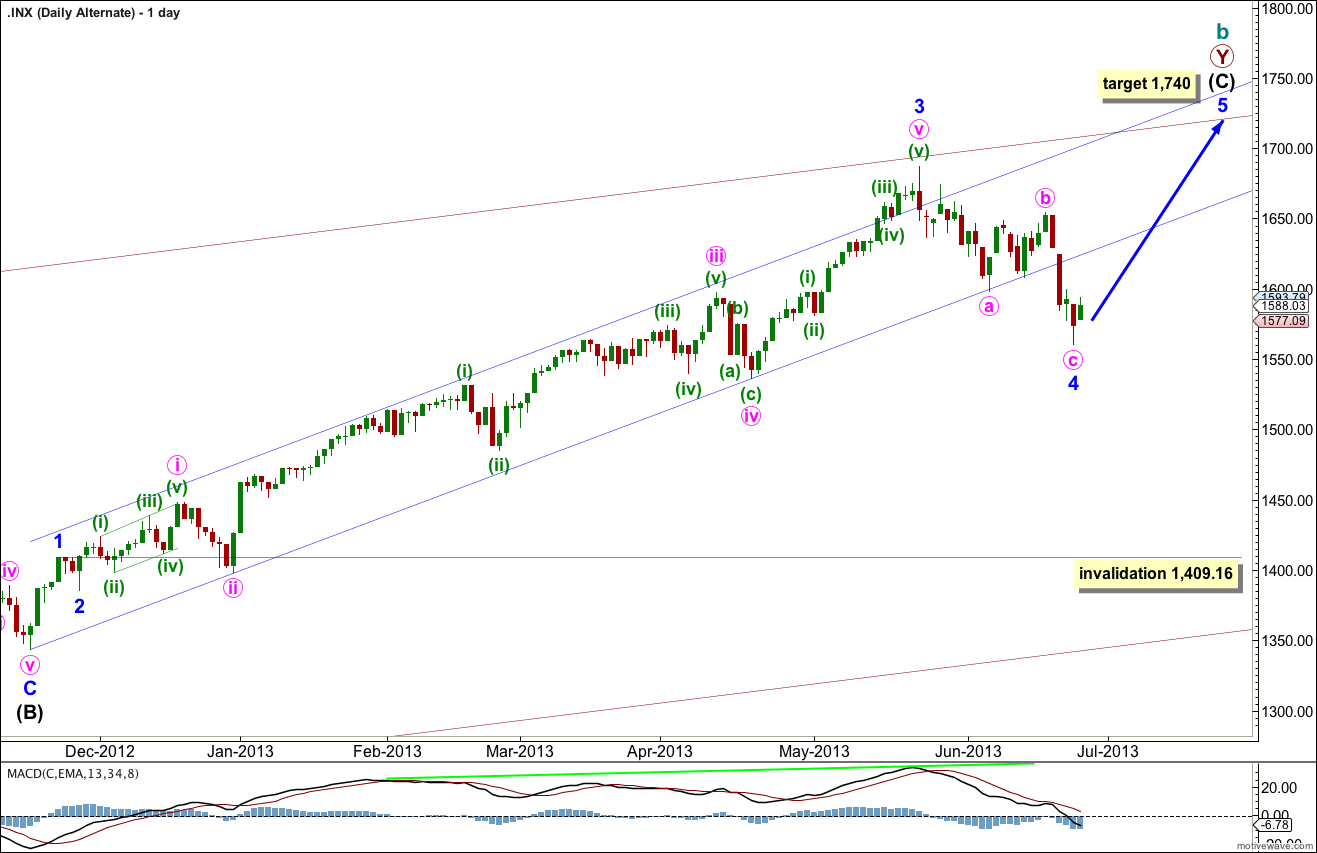The main wave count from last analysis expected downwards movement, but allowed for the possibility that a small second wave correction could move higher. Price moved higher during the Tuesday’s session and has remained below the invalidation point on the hourly chart.
Click on the charts below to enlarge.
Main Wave Count.
The widest maroon channel is copied over from the monthly chart and contains all of cycle wave b. It may be that price found final resistance at the upper edge of this channel.
The black channel in the middle is drawn about the zigzag of primary wave Y. Draw the first trend line from the start of primary wave Y to the end of intermediate wave (B). Place a parallel copy upon the extreme within intermediate wave (A). The upper edge of this channel also may be where price found resistance and where intermediate wave (C) ended.
The smallest blue channel is the most conservative best fit I can see for intermediate wave (C). It is very clearly breached by downwards movement.
I have looked back to September 2000 on the daily chart at smaller narrow channels about intermediate degree movements. Most of the time a breach like this indicates a trend change, but not always. What would give me more confidence in this trend change is a clear breach of the black intermediate degree channel. When that is breached I will calculate downwards targets for you.
There is no classic technical divergence between price and MACD on the daily or weekly charts. This is possible, but unusual for the S&P 500. This must reduce the probability of this wave count. We must still seriously consider the alternate.
There are no Fibonacci ratios between minor waves 1, 3 and 5 within intermediate wave (C). There is no Fibonacci ratio between intermediate waves (A) and (C). This lack of Fibonacci ratios slightly reduces the probability of this main wave count.
Minor wave 2 may not move beyond the start of minor wave 1. This wave count is invalidated with movement above 1,687.18.
Within minuette wave (iii) subminuette wave ii moved higher. Within it there is no Fibonacci ratio between micro waves A and C.
There is now almost no room left for upwards movement for subminuette wave ii. It must be over here. This wave count expects strong downwards movement tomorrow and maybe also the day after as subminuette wave iii within minuette wave (iii) within minute wave iii unfolds.
At 1,525 minuette wave (iii) would reach 1.618 the length of minuette wave (i). This target may be one or two days away now.
Subminuette wave ii may not move beyond the start of subminuette wave i. This wave count is invalidated with movement above 1,598.31.
If this wave count is invalidated tomorrow with upwards movement then it would be possible that a leading diagonal is unfolding to the downside for minor wave 1. The invalidation point for this alternate idea would be at 1,687.18. However, a leading diagonal is less common than an impulse in a first wave position. It is possible, but at that stage the alternate would start to be more likely.
Alternate Wave Count.
The biggest problem with this wave count and the reason it is an alternate is the size of minor wave 4: it is out of proportion to all the other corrections within intermediate wave (C) and clearly breaches a channel containing intermediate wave (C) no matter how that channel is drawn. Sometimes fourth waves do this and so we must consider this possibility.
Within intermediate wave (C) minor wave 3 is 23 points longer than 4.236 the length of minor wave 1.
The lack of classic technical divergence between price and MACD supports this wave count. A final fifth wave up with slowing momentum would provide divergence and give a typical look.
At 1,740 intermediate wave (C) would reach equality with intermediate wave (A).
Minor wave 4 may not move into minor wave 1 price territory. This wave count is invalidated with movement below 1,409.16.
So far if minor wave 5 has begun minuette wave (i) within minor wave i may be complete.
Movement above 1,654.19 would provide a little confidence in this wave count, but it would not invalidate the idea of a leading diagonal for the main wave count.
Full confidence would come with movement to a new high above 1,687.18.





Lara, in your main case don’t you think green minuette ii looks a bit odd, and in fact what you have as i orange subminuette in wave iii minuette green is in actual fact wave v orange subminuete of wave i green?
It is possible, but it does not have as good a fit in terms of structure.
If a leading diagonal ended there then within it the third wave would be shorter than the first, and the fifth wave would be shorter than the third indicating a contracting diagonal. But the fourth wave would be slightly longer than the second indicating an expanding diagonal.
This may still be possible, sometimes diagonal wave lengths are not as expected. So long as the third wave is not the shortest, the fourth overlaps first price territory and all subdivisions are correct it could be just acceptable. But this does reduce the probability.
If we consider this then it means the invalidation point is higher at 1,448. But minor waves 2 and 4 are still well out of proportion, the whole thing still has an odd look, and still does not fit nicely in a parallel channel. So it really does not make enough of a difference to increase probability for the alternate.
I know it looks odd because the proportion of minute ii is bigger than minor 2, but I have labeled this in this way because the subdivisions fit so perfectly.